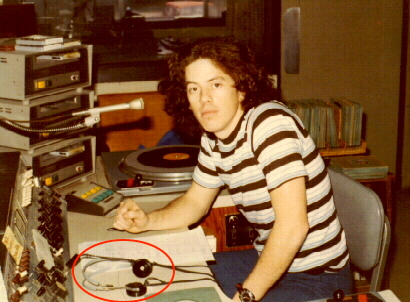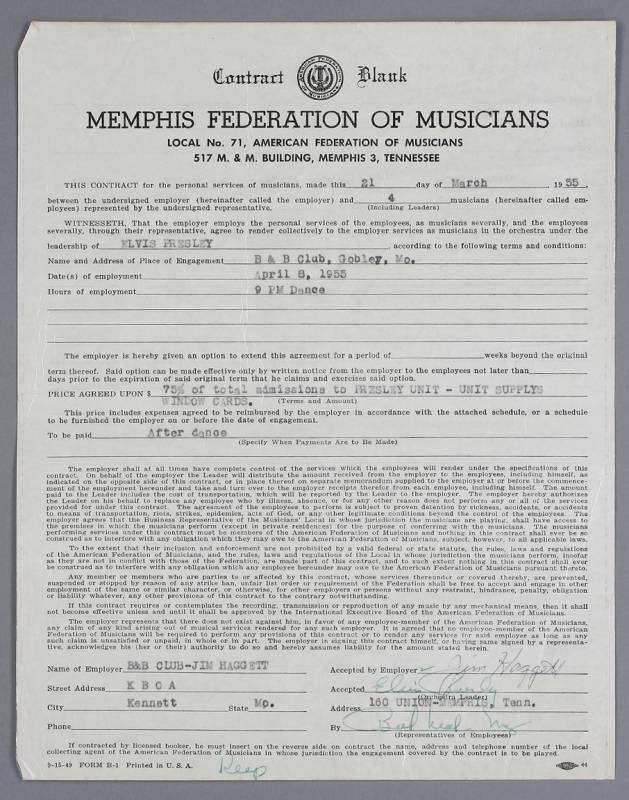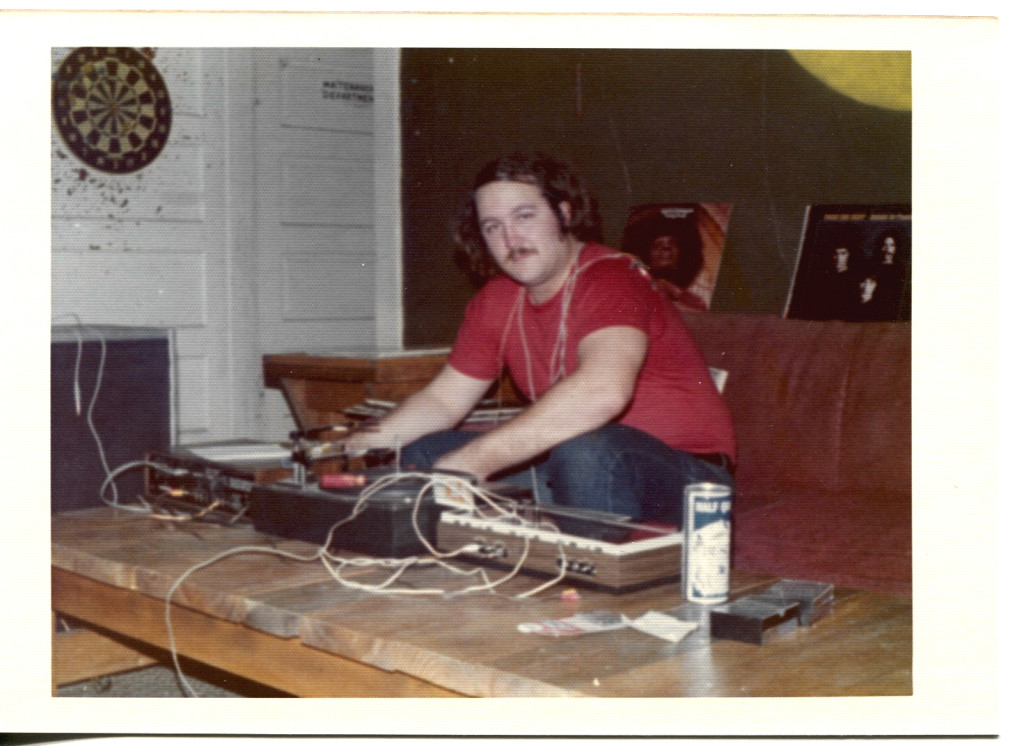Just stumbled across these guys on Apple Music. Reminds me of someone from the sixties but can’t think of who.
Tag Archives: music
AirPods
I spent some money on headphones back in the 70s. When I started at KBOA in ’72 all they had were these WWII-era Bakelite hockey pucks with a piece of vibrating tin inside.

When I saw my first pair of Sennheiser open-air headphones (in a magazine) I ordered a pair and paid for them myself. And, yes, I took them into the studio for my shift and took them with me when done. They were pretty expensive (for the time) and a bit fragile. But I sounded soooo good in those headphones. More accurately, I could hear what I really sounded like and that was important.

Fast forward several light years to the first iPods and the famous white earbuds that all serious music buffs hated. I loved them. They sounded fine to me and they fit my ears just fine. I’ve been using them ever since, pretty much every day.
In a few weeks Apple will start selling AirPods ($150) and I’ll buy a pair on Day One. And I might not be the only one. From Business Insider:
12% of U.S. consumers surveyed by Bank of America Merrill Lynch say they intend to purchase AirPods, apparently on the strength of Apple’s marketing, given that few people have actually seen and tried them out. This is a very bullish sign for Apple, says BAML. “12% of the US installed base could lead to up to an incremental $3bn in revenue,” writes the analysts.
“Apple’s marketing” is one explanation. Another might be that people like me have been using Apple earbuds for fifteen years and like them.
Apple Music changing the way I think about music
Not sure I can explain this but let’s give it a shot. Raise your hand if you’re old enough to remember “collecting websites.” This was back in the early days of the web and long before Google made it easy to find your way back to a favorite site. Bookmarks were an important part of your web browser. It wasn’t uncommon to have dozens (hundreds?) of bookmarks. So many you needed a folder structure to keep them all organized. I don’t know many who still maintain such lists. Modern browsers do a pretty good job of keeping up with your favorites sites based on your surfing habits.
I’m seeing a similar evolution in my music listening habits. I still have some playlists I created in iTunes. These are lists of songs I purchased and downloaded. Or, more recently, just downloaded from Apple Music. But I’m finding it increasingly cumbersome to navigate these lists when compared to the way Apple Music connects me to music. Where my playlists are static (the same songs), Apple Music playlists are updated with fresh songs. I don’t know if this is true of all playlists or just some. But the result is a fresher, more dynamic experience. In some ways this feels like listening to a good radio station where the music rotation is the best blend of favorites and new stuff like the favorites. I told you… difficult to explain.
There are some classics I’ll always want to keep close (Mad Dogs and Englishmen, Harvest, Tapestry, etc) but I’m feeling less need to organize and manage “my” (i.e. downloaded) songs. If I’m in the mood for some funk or a Janis Joplin song Apple Music will deliver the good far better than my collection. My downloaded library is finite where Apple Music is infinite but increasingly aware of what I like (or might like).
1966: “rock ‘n’ roll” became “rock”
“But 50 years down the line, a case can be made that 1966 may have been the single most creatively expansive year of all. That was the year that “rock ’n’ roll” morphed into “rock,” the year that the 45 rpm single yielded to the 33 1/3 rpm long-playing album as the dominant medium for the music and the year that social and political issues became a regular topic of exploration among musicians looking beyond the next hit and aiming to exert a real impact on the world around them.”
— 1966: Rock ‘n’ roll’s most revolutionary year (Los Angeles Times)
Curated music playlists
I’m a big fan of curated playlists (Apple Music for me) and have been curious about how and by whom these lists are created. This longish article is the best look at this I’ve read to date.
“Spotify says 50% of its more than 100 million users globally are listening to its human-curated playlists (not counting those in the popular, algorithmically personalized “Discover Weekly”), which cumulatively generate more than a billion plays per week. According to an industry estimate, 1 out of every 5 plays across all streaming services today happens inside of a playlist.”
“Music fans […] can smell the difference between a service where much of the product is dictated by algorithms or charts and one that is guided by more knowledgeable but equally passionate versions of themselves.”
Secretive as always, “Apple declined to share how many of those users are going to its playlists and how often.”
Seeing the music
There is something deeply satisfying about watching talented musicians, as opposed to just listening to the music. This occurred to me while watching the Playing for Change videos, especially the “live outside” performances, which I find far more moving and satisfying than the highly produced ‘music videos’ that a big record label might create for a popular artist.
I got a brief glimpse of this a few years ago when I visited John Walkenbach and Bisbo Nian. I got to watch each of them jamming with with some of their musician buddies and came away thinking it was more than just playing their instruments. It was playing with other musicians. One of those sum-of-the-parts things.
In conclusion, I’m wondering if our brains process music differently if we’re watching the musicians. I assume different parts of the brain will “light up” in response to the visual but what I’m wondering is are we hearing differently when we see the music being made. This seems like a question that should have been asked and answered.
Mavis!
This is why I love Apple Music
You know I love my Apple Music playlists. And have wondered aloud who puts these together. Steven Levy wondered the same thing:
“Who are those editors putting the playlists together? It turns out they are music nerds who might have otherwise been displaced by technology. People from radio; people who used to work at publications; people who used to work at record companies — hard core passionate music people. They check in to work at offices in Cupertino or LA (though a few work remotely) and perform curation tasks that include making those playlists, which they draft and discuss in meetings that must be more fun than the ones at your job. The important thing is that they are human beings. Apple believes that only flesh-and-blood music lovers can properly select and format these lists, artfully making the segues from one tune to the next.”
“They are very much like those cosmic deejays in the early days or FM, or today’s superstar spinners at Las Vegas casinos and high end clubs everywhere. But without a direct channel to communicate with the audience — no microphone to explain yourself between blocks of song — it’s a weird kind of communication they have with their audience. […] After listening to a lot of these playlists, I feel I almost know whoever it is at Apple who specializes in Americana, Blues, and 60s rock.”
Apple Music has a Connect feature where fans can ‘connect’ with their favorite artists. I have zero interest in doing that but would love to connect with the people who create the playlists.
Early Elvis contract

In 1955 Elvis Presley appeared at a little honky tonk called the B & B Club, in Gobler, MO. Not far from my hometown of Kennett, MO. More information here, including an audio clip with my father who was working at the local radio station. The contract above is between Elvis and Jimmy Haggett, who also worked at KBOA and booked entertainers on the side. If you look closely you’ll see Elvis was to receive 75% of the gate to be paid “after dance.”
Mix-Tape

Want to take your music with you? Then you’re gonna have to work for it. This is Charlie making a mix-tape back in 1974. Amp on the left. Turntable in the middle. Two-deck cassette recorder on the right. When the cassette if full, there was a “high speed” dubbing mode so you could crank out extras for friends.
